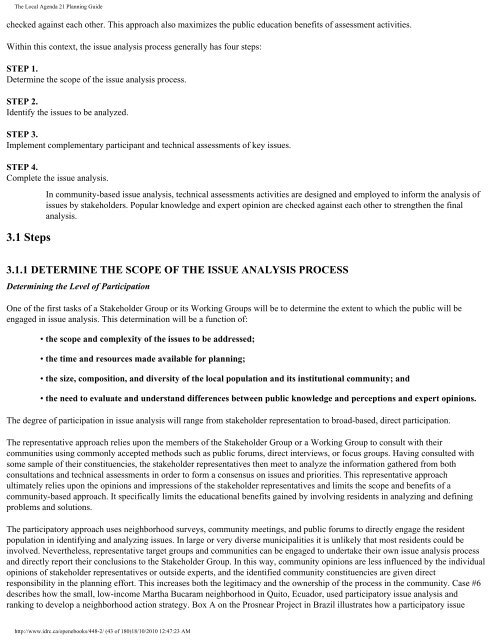The Local Agenda 21 Planning Guide - Democrats Against UN ...
The Local Agenda 21 Planning Guide - Democrats Against UN ...
The Local Agenda 21 Planning Guide - Democrats Against UN ...
You also want an ePaper? Increase the reach of your titles
YUMPU automatically turns print PDFs into web optimized ePapers that Google loves.
<strong>The</strong> <strong>Local</strong> <strong>Agenda</strong> <strong>21</strong> <strong>Planning</strong> <strong>Guide</strong><br />
checked against each other. This approach also maximizes the public education benefits of assessment activities.<br />
Within this context, the issue analysis process generally has four steps:<br />
STEP 1.<br />
Determine the scope of the issue analysis process.<br />
STEP 2.<br />
Identify the issues to be analyzed.<br />
STEP 3.<br />
Implement complementary participant and technical assessments of key issues.<br />
STEP 4.<br />
Complete the issue analysis.<br />
3.1 Steps<br />
In community-based issue analysis, technical assessments activities are designed and employed to inform the analysis of<br />
issues by stakeholders. Popular knowledge and expert opinion are checked against each other to strengthen the final<br />
analysis.<br />
3.1.1 DETERMINE THE SCOPE OF THE ISSUE ANALYSIS PROCESS<br />
Determining the Level of Participation<br />
One of the first tasks of a Stakeholder Group or its Working Groups will be to determine the extent to which the public will be<br />
engaged in issue analysis. This determination will be a function of:<br />
• the scope and complexity of the issues to be addressed;<br />
• the time and resources made available for planning;<br />
• the size, composition, and diversity of the local population and its institutional community; and<br />
• the need to evaluate and understand differences between public knowledge and perceptions and expert opinions.<br />
<strong>The</strong> degree of participation in issue analysis will range from stakeholder representation to broad-based, direct participation.<br />
<strong>The</strong> representative approach relies upon the members of the Stakeholder Group or a Working Group to consult with their<br />
communities using commonly accepted methods such as public forums, direct interviews, or focus groups. Having consulted with<br />
some sample of their constituencies, the stakeholder representatives then meet to analyze the information gathered from both<br />
consultations and technical assessments in order to form a consensus on issues and priorities. This representative approach<br />
ultimately relies upon the opinions and impressions of the stakeholder representatives and limits the scope and benefits of a<br />
community-based approach. It specifically limits the educational benefits gained by involving residents in analyzing and defining<br />
problems and solutions.<br />
<strong>The</strong> participatory approach uses neighborhood surveys, community meetings, and public forums to directly engage the resident<br />
population in identifying and analyzing issues. In large or very diverse municipalities it is unlikely that most residents could be<br />
involved. Nevertheless, representative target groups and communities can be engaged to undertake their own issue analysis process<br />
and directly report their conclusions to the Stakeholder Group. In this way, community opinions are less influenced by the individual<br />
opinions of stakeholder representatives or outside experts, and the identified community constituencies are given direct<br />
responsibility in the planning effort. This increases both the legitimacy and the ownership of the process in the community. Case #6<br />
describes how the small, low-income Martha Bucaram neighborhood in Quito, Ecuador, used participatory issue analysis and<br />
ranking to develop a neighborhood action strategy. Box A on the Prosnear Project in Brazil illustrates how a participatory issue<br />
http://www.idrc.ca/openebooks/448-2/ (43 of 180)18/10/2010 12:47:23 AM










